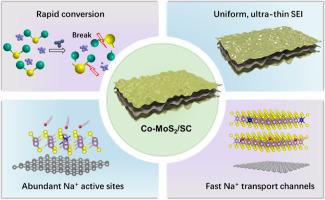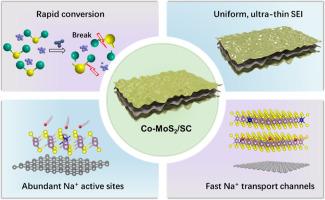Atomic Co-driven catalysis in MoS₂ for accelerated charge transfer and stable interfacial chemistry in sodium-ion batteries
IF 20.2
1区 材料科学
Q1 CHEMISTRY, PHYSICAL
引用次数: 0
Abstract
Maximizing initial Coulombic efficiency (ICE) is crucial for the practical deployment of sodium-ion batteries (SIBs), yet remains challenging due to uncontrolled interfacial side reactions and sluggish charge transport. Here, we present an in situ electrochemical catalysis strategy enabling atomic-level Co doping in MoS₂, which simultaneously regulates its electronic configuration and interfacial chemistry. The engineered Co–S–C catalytic sites accelerate the cleavage of P–F and C–O bonds from NaPF₆ and diglyme, respectively, inducing rapid formation of an ultrathin, highly conductive inorganic-rich SEI layer. This suppresses irreversible parasitic reactions and drastically enhances ICE to an unprecedented 96 %. Additionally, Co incorporation drives a 2H-to-1T phase transition via Mo 4d orbital reorganization, weakening Mo–S bonds and boosting Na⁺/electron transport. The resulting Co–MoS₂/SC anode delivers exceptional electrochemical performance, with 288 mAh g⁻¹ at 20 A g⁻¹ and 96 % capacity retention over 2000 cycles at 10 A g⁻¹. This work offers a powerful strategy for interfacial catalysis-driven phase engineering, unlocking new opportunities for high-efficiency, high-rate sodium storage.


钠离子电池中加速电荷转移的MoS 2原子共驱动催化和稳定界面化学
最大化初始库仑效率(ICE)对于钠离子电池(sib)的实际部署至关重要,但由于不受控制的界面副反应和缓慢的电荷传输,仍然具有挑战性。在这里,我们提出了一种原位电化学催化策略,使原子水平的Co掺杂在MoS₂中,同时调节其电子构型和界面化学。设计的Co-S-C催化位点分别加速NaPF₆和diglyme的P-F和C-O键的裂解,诱导超薄、高导电性的富无机SEI层的快速形成。这抑制了不可逆的寄生反应,并大大提高了ICE到前所未有的96%。此外,Co的掺入通过Mo 4d轨道重组驱动2h到1t的相变,减弱Mo - s键,促进Na⁺/电子传输。所得到的Co-MoS 2 /SC阳极具有卓越的电化学性能,在20 A g⁻¹下具有288 mAh的容量,在10 A g⁻¹下可以保持96%的容量。这项工作为界面催化驱动的相工程提供了一个强有力的策略,为高效率、高速率的钠储存提供了新的机会。
本文章由计算机程序翻译,如有差异,请以英文原文为准。
求助全文
约1分钟内获得全文
求助全文
来源期刊

Energy Storage Materials
Materials Science-General Materials Science
CiteScore
33.00
自引率
5.90%
发文量
652
审稿时长
27 days
期刊介绍:
Energy Storage Materials is a global interdisciplinary journal dedicated to sharing scientific and technological advancements in materials and devices for advanced energy storage and related energy conversion, such as in metal-O2 batteries. The journal features comprehensive research articles, including full papers and short communications, as well as authoritative feature articles and reviews by leading experts in the field.
Energy Storage Materials covers a wide range of topics, including the synthesis, fabrication, structure, properties, performance, and technological applications of energy storage materials. Additionally, the journal explores strategies, policies, and developments in the field of energy storage materials and devices for sustainable energy.
Published papers are selected based on their scientific and technological significance, their ability to provide valuable new knowledge, and their relevance to the international research community.
 求助内容:
求助内容: 应助结果提醒方式:
应助结果提醒方式:


